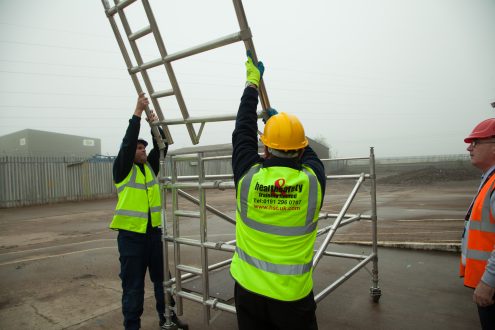MEWPS: How to Avoid Trapping & Crushing
Mobile Elevated Working Platforms (MEWPs) are the safest way of positioning workers at height for temporary jobs as they provide efficient access to high areas and protect the workers from the risk of falling.
Trapping & Crushing
However, MEWPS are not completely risk free. One of the biggest safety concerns for workers on MEWPs is ‘trapping’. This is more likely with boom type MEWPs and happens when the platform or basket is elevated reversed or slewed in a way that crushes the operative between the platform and an overhead obstruction. The injuries that result can be serious and even fatal.
In some of the worse cases the operator’s body can be trapped between the obstruction and the control panel, so the basket/platform can not be turned off or moved.
Contributing Risk Factors
MEWPs should only ever be operated by trained and certified operators, who are able to recognise and avoid potential hazards, such as:
- Inadequate route planning
- Incorrect MEWP equipment for the task at hand
- Insufficient MEWP training and familiarisation
- Uneven ground
- Poor visibility at height
- Operator distracted from task
- Excessive drive speeds
- Faulty or badly maintained MEWPs
Reducing the Risks
- Planning a route
The route should be planned before the task commences. This is especially important if the work is close to overhead structures, as it has a higher risk factor attached to it. The route should take into account maintaining a sensible distance between the MEWP and any overhead structures and this distance should be greater for boom MEWPs as they can unexpectedly seesaw and bounce.
If the task means you must be close to an overhead structure, the drive, slew and elevate controls should be avoided once near the obstruction and the finer positioning controls used instead.
The MEWP should never be driven while the boom is in use. All driving should be done before elevating the platform as it can create unexpected movements and difficult with the fine positioning. If this is unavoidable, driving should always be at the slowest possible speed.
- Choosing the right MEWP
The MEWP chosen for a specific task should always be appropriate for the planned route and maneuvers.
Careful consideration should be paid to the reach and extending capabilities of the equipment, so you do not chose a machine that will be operating right on it’s limit, as well as the clearance of the MEWP, to ensure the platform is not too big for the space it needs to reach into.
- Specific Machine Familiarisation
Operators should be properly trained and familiarised with the specific MEWP chosen for the task. The most important controls to understand are emergency descent controls, the ‘dead man’ controls (foot pedals) and the controls for operating the platform when it reaches past the 90 degree position.
Group personnel should also be trained in line with your emergency rescue plan to operate the ground controls and lower the platform in an emergency situation.
- Ground Conditions & Visibility
A MEWP should not be operated if the ground conditions are poor. Any trenches, pits or hollows in the ground should be protected against any obstruction in the operating zone should be removed.
If visibility or light is poor, work should be suspended until adequate lighting can be supplied.
- Remove Distractions
Personal distractions, such as mobile phones, should be banned from the platform.
Any loose materials, tools or cables should be carried in an approved container, or using specialist attachments to avoid distraction and accidents. Anything that could cause a distraction from the ground should be handled before the task commences. This includes unnecessary people and obstacles that should be removed from the exclusion zone.
- Sensible Operation
Maintain a slow speed while driving the MEWP, especially during reversing maneuvers. Continually scan for potential obstacles throughout the maneuver, and halt work if you discover one until it can be removed or protected against. Never lean over the guard rails.
- Faulty MEWPS
Never use a machine you know has a fault. Always check the MEWP has a valid thorough examination certificate and carry out daily inspection and safety tasks to ensure nothing is overlooked. If you discover any faults report them immediately and decommission the MEWP until the problem has been rectified.
- Emergency Rescue Plans
- The ground key should be kept with the ground team. If this is not possible, it should be available quickly in case of emergency.
- At least one ground rescue person, who has been familiarised with the rescue plan and controls, should always be available throughout the maneuver.
- There should be a system in place to raise the alarm should an operator become trapped, especially if the operator is not visible from ground level.
- Decide who will effect the rescue (operator or ground rescue person), depending on the risk level and the type of entrapment.
- The risk to the operator should always be the highest priority, so if they can safely rescue themselves, they should. The ground staff should only be used if the visibility from the ground is clear, and they clearly understand the situation. Another MEWP should only be used to effect a rescue as a last resort.
- If the risk of entrapment is high, a dry run may be required to check for any potential hazards.
- Rescue plans should be practiced and adapted regularly.
For more information about the use of MEWPs, planning a rescue plan and training your staff to ensure safe operation, contact the team at Health and Safety Training Ltd. We can tailor training courses for your team to provide them with the skills, knowledge and certifications they require to work effectively with MEWPs.
Why is Construction one of the Most Dangerous Jobs in the UK? The Dangers of Casual Forklift Training






